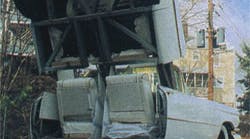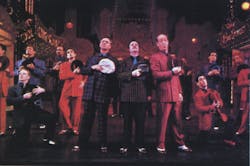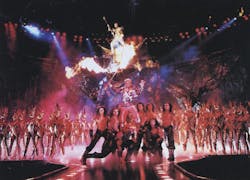Hydraulics usually is called on to generate motions that require high force, rapid movement, and precise positioning. This is true of industrial applications as well as those in the entertainment industry — especially today’s big theme parks. Although these characteristics often are demanded in legitimate (live) theater productions, they do not necessarily play the lead role. Versatility is just as important or perhaps more so because a system must operate successfully even if application parameters change drastically after a system has been installed. The ability to tune — not just fine-tune — operation of an electrohydraulic system may be its most beneficial quality for live theater.
Versatility holds down costs
Ideally, hydraulic systems for legitimate theater should be designed to operate close to capacity. However, such systems often would have to be redesigned because new loads and speeds often exceed those originally specified. These re-engineering costs exceed many times over the cost of building an oversized system to begin with. More importantly, designing and installing a system that ends up being too conservative not only costs the builder money by having to do a system over again, but can also destroy his credibility.
If one of my systems doesn’t get finished on time because I have to reconfigure it, I may never work again in this industry. Once word gets out that your system delays an opening or doesn’t perform as expected, you cannot expect a second chance. I learned this lesson after my first project, — we built a winch that had to lift 12 people at once. Fortunately, the system worked, but if one actor had a sandwich in his pocket, it wouldn’t have. That’s how close to capacity it was designed.
Now, we usually oversize everything 100%. If a design calls for flow of 15 gpm, and I’m not absolutely certain that we’ll need only 15 gpm — or if a colleague thinks we might need more — we size everything for 30 gpm. We always use variable-displacement pumps on our power units, so we’re turning all this extra capacity into heat. It’s well worth the money because even if the system is oversized, it will work right the first time.
In a sense, hydraulics gives you room to be wrong. If you decide on a 3-hp electric motor, and a 3-hp motor doesn’t work, increasing electrical power transmitted to the motor will only burn it out. When you have only three to six weeks to complete a project, and you know you’ll have to make changes down the road, you must have a system that makes implementing changes convenient. That’s what the versatility of hydraulics gives you. If you need more speed out of a hydraulic motor, you can increase flow. If you need more torque, just let the system run at a higher pressure, within reason, of course.
Fear of hydraulics
Many contractors for shows avoid using hydraulics because the thought of all that oil over the heads of live actors is scary. It still scares me because the hydraulic components are not sitting up in their own pristine little world; they’re nested within the scenery. If something blows, the oil isn’t going to be contained. It’s going to go everywhere. The potential for ruining hundreds of thousands of dollars of scenery and costumes seems minor in comparison to getting hot oil on the actors. If this happened, you’d suddenly see contracts written prohibiting the use of hydraulics anywhere near live actors.
Tony Award winning technology
Even if electromechanical components could have been used, noise was another consideration. Having an individual electromechanical actuator move each of the huge plywood panels — which act as sound amplifiers — would have been loud enough to overpower actors’ voices.
Still another advantage of hydraulics was the ability to move these large props smoothly. Soft-shift valves were used because they provide a ramping effect for controlling acceleration and deceleration without the expense and complexity of proportional valves. Soft-shift valves work especially well in Guys and Dolls because the large, lightweight props tend to shake if started or stopped suddenly. With the soft-shift valves, they start and stop smoothly.
The potential liability becomes even greater with shows like Starlight Express. In this 1989 production, actors skated on articulated bridges. One of these bridges pivoted to a position where a portion of it was over the audience. Imagine the liability of oil gushing or even just dripping out of the bridge onto the audience, many of whom would be wearing formal attire
Whether justified or not, this fear of leakage is the main reason some contractors avoid using hydraulics. Instead, they use ballscrews driven by variable-speed DC motors. The preference for electrical connections over hydraulic is another perhaps misguided policy. Electrical cable is thought to be more flexible than hydraulic hose, and it doesn’t leak. But with the wide availability of hose that exceeds current standards for flexibility, hydraulic hose can be easier to work with than electrical cable.
One can understand some people’s reluctance to use hydraulics if they still perceive hydraulic systems plumbed with pipe fittings instead of straight-thread, flat-faced fittings. We don’t use pipe fittings. Period.
Advantages of hydraulics
Even though cylinders often are used for their linear motion capability, we also call on hydraulics for rotational motion on much of our equipment. In the past, we may have driven a cable and drum assembly with a variable-speed DC motor through a gearbox. But we’re changing over more and more to low-speed/high-torque motors to drive drums directly. We started using these LSHT motors for hoisting loads of 5000 lb or greater. LSHT motors eliminate the need for gearboxes, which reduces installation time and cost.
Costs are reduced further just by taking advantage of the hydraulic power unit. As long as we have to have a power unit installed to run the cylinders, we can distribute the cost of the power unit over every hydraulic function. Because cost of installing and operating the power unit is relatively fixed, the more hydraulic actuators we use, the more cost-effective hydraulics becomes because we can more widely distribute the cost of the power unit.
Safety is another advantage of hydraulics. It’s easy to set up stall conditions by using crossport relief cartridge valves or other standard components. If something locks up, instead of having a DC motor burn itself out or shear the teeth off a gear, it’s very easy to control pressure applied to any component, and without a lot of fancy electronics or torque limiters.
System hardware
Much of the hardware used in shows might, at first, seem identical to that used in theme parks. While this is sometimes true, duty cycles of components used in theater productions come nowhere near those of theme parks. Attractions in theme parks must cycle hundreds of times a day, seven days a week. In these applications, hardware is designed, constructed, and assembled almost as if it were industrial material-handling equipment.
Equipment for the theater must be just as reliable, but duty cycles, in general, run only a few times a day. Of greater importance is the ability to assemble equipment quickly and get it operating, regardless of how great loads and speeds deviate from original specifications. In fact, if a show really flops, equipment may cycle only a few times in front of an actual audience. On the other hand, equipment in successful shows may operate for months on end.
If a show does run for only a short time, it would seem that parts could be recycled for future productions. Power units almost always can be applied over and over. This again illustrates the versatility of hydraulics because a power unit can be put on line for a production and pump displacement scaled down to the flow required.
For example, the power unit used in Guys and Dolls had formerly been used in the Teenage Mutant Ninja Turtles musical show that toured the continent. This power unit is much larger than what was required for Guys and Dolls, but using it saved us from having to make a new one, which, ultimately, helped us land the contract of a very successful show.
Other components, such as long sections of hose and cartridge valves can be recycled for more than one show. We have standardized our hose assemblies by installing female fittings at both ends. By doing so, we can re-use a hose assembly and not have to delay assembly of the set because we need an adaptor.
Custom hardware
We custom build some of our equipment as a cost-effective alternative to commercially available equipment. This is because we use 10-turn pots almost exclusively as input devices. Commercial controls must accept a variety of input signals, so, naturally, they have to have more complex cicuitry, which, of course, adds to its cost. In a few cases, we even sell some of our equipment to outside industries, if, for example, they also use ten-turn pots as their primary input device.
Moreover, much of what we need would not be available off-the-shelf from most manufacturers. For example, 120 ft of linear travel is not unusual for us. We may need only 1/8 in. repeatability over that 120-ft stroke, so it’s hard to justify paying for something with capabilities beyond that required unless it will be used repeatedly.
We also generally don’t close the velocity loop. We control velocity through software, so it wouldn’t be practical to purchase an industrial control with velocity control as standard equipment. We could control position with respect to time, but having a time-based control costs more. Besides, we usually don’t know how fast something should run because everything is being built for the first time.
We did build a time-based system for controlling the motion of a dragon used in the Sigfried and Roy show in Las Vegas. Among the myriad of moving platforms and sets, a dragon with a 60-ft wingspan and over 30 axes of hydraulically actuated motion appears to engage in battle with the show’s stars. Motion of the dragon is controlled by a computer that was programmed from ten dual-axis joysticks. A trained operator would impart movement to the dragon through the joysticks. Variable-voltage output of these joysticks was then recorded in EPROM and played back. Any segment of the program could then be edited any number of times until achieving the desired effect. The computer integrated ramps into the command signals to smooth out any abrupt changes that may have been introduced by editing.
An advantage of our control system over, say, an industrial programmable logic controller (PLC) is that we change command signals simply by rerecording a particular segment. Because PLCs use ladder-diagram logic, any changes in the program must be made in the ladder-logic program.
For example, in Miss Saigon, we made a Cadillac whose rear half could fold up to a vertical position because backstage room was so limited. As the Cadillac moved forward, the rear half would begin unfolding downward. We originally had only two limit switches for the motion — fully folded and fully unfolded. Later, we had to add an intermediate limit switch. Because the show’s main program was controlled by a PLC, a programmer had to search for the exact switch closure in the ladder logic program before the change could be added there.
Dan Hoffman is vice president and director, electronic and motion control division, Showtech, Inc., South Norwalk, Conn.




